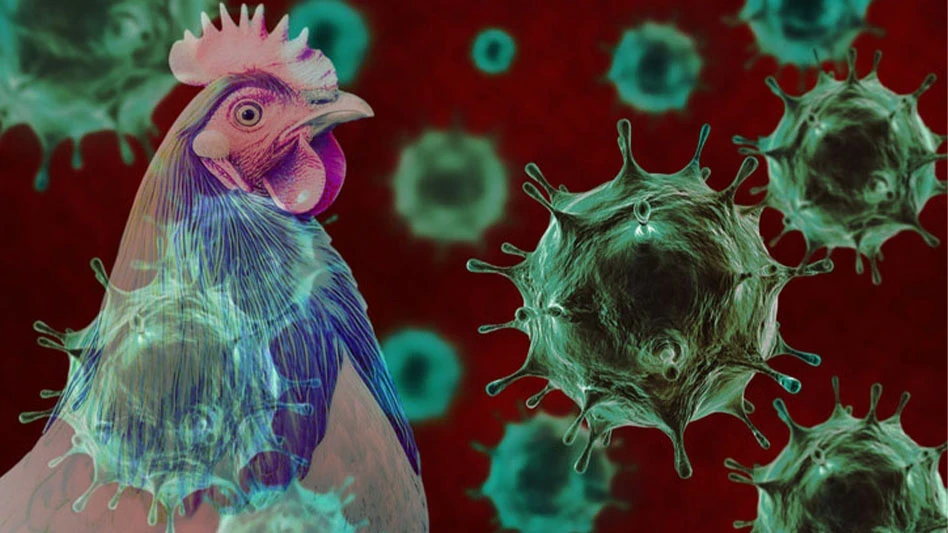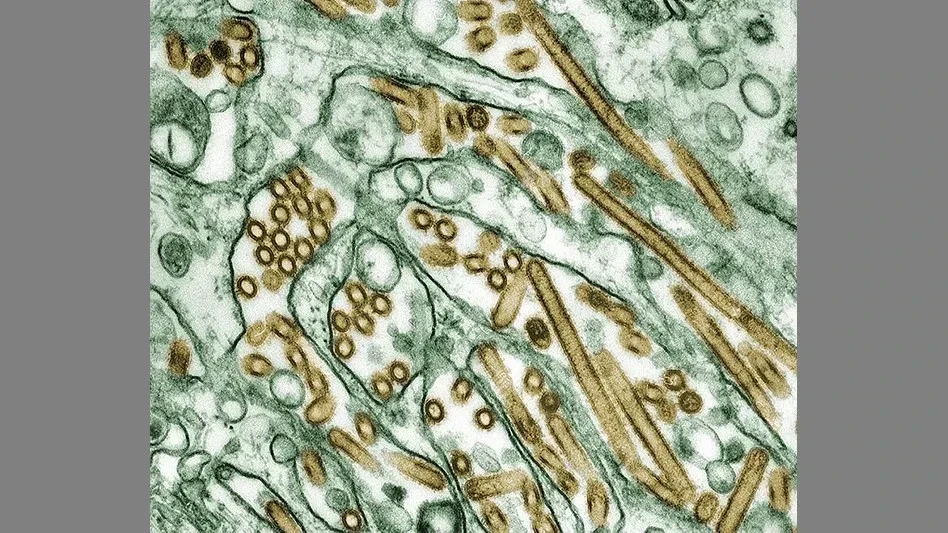 In an effort to make his facility more attractive, a maintenance engineer planted several Spirea shrubs near the plant entrance. That spring, when the Spirea buds were in full bloom, the engineer was very happy with his choice. However, inside the plant was a different story. Every day, more and more adult Dermestidae beetles, commonly known as warehouse beetles, were found. After conducting several facility self-inspections, the food safety team determined the cause. The pollen from the Spirea blooms had attracted the beetles.
In an effort to make his facility more attractive, a maintenance engineer planted several Spirea shrubs near the plant entrance. That spring, when the Spirea buds were in full bloom, the engineer was very happy with his choice. However, inside the plant was a different story. Every day, more and more adult Dermestidae beetles, commonly known as warehouse beetles, were found. After conducting several facility self-inspections, the food safety team determined the cause. The pollen from the Spirea blooms had attracted the beetles.
This problem is not uncommon. Facilities throughout the world make similar mistakes. Often, pest problems are an unintentional result of the choices made in the selection of landscape plants around the facility. Unfortunately, the plants that are appropriate for food facilities depend on several variables, such as region, climate, and other environmental concerns. Since there is no standard regulation applicable to facilities, most learn which landscaping materials not to plant around or near a food facility by trial and error.
Steer Clear of These Mistakes
There are some common landscaping mistakes that are recognized in the food industry. For example, most maintenance engineers know that plants with fruits, nuts, berries, seeds, or blossoms will attract many species of insects, rodents, and birds, as well as other wildlife. For that reason, you will rarely see a tree or shrub of that type in close proximity to a food plant. Most engineers are also aware that planting thick ground covers around the perimeter of a facility provides excellent harborages for rodents.
Unfortunately, for every landscaping issue about which a maintenance engineer is educated, there are several more of which he is unaware. Learning about common landscape mistakes that other facilities have made is a great way to prevent your facility from making similar errors. When selecting plants and shrubs for outside grounds, keep the following considerations in mind.
Avoid planting trees close to buildings. As they grow, branches may overlap the roof of the building and provide easy access for pests such as mice, rats, and carpenter ants. If you notice that tree branches are growing too close to buildings, trim and maintain them to prevent pest infestations.
Trees that produce fruit not only contribute to bird problems, but they are also a source of insect infestations. For example, crabapple trees may be visually pleasing, but when the apples fall to the ground and rot, they attract various insects including flies and yellow jackets. Furthermore, these types of trees require a great amount of maintenance. When the fruit begins to fall, daily removal is necessary to prevent infestations.
Yew shrubs and other low evergreen shrubs should not be planted close to the building. As the branches sag, harborage gaps that can attract pests are formed. Also, food wrappers and debris get trapped beneath these shrubs, providing rodent nesting material.
If these types of shrubs are planted near your facility, either remove them or make sure that the branches are trimmed to remove harborages and make cleaning easier.
Certain trees attract various insect species, depending on the region. For example, in Kansas and Kentucky, some maple-tree species are classified as having no serious diseases or insect attraction. However, in Oklahoma and Iowa, horticulturalists strongly advise against planting these near a food facility, as they are known to attract boxelder bugs. Other variations occur between states. A certain type of plant may be highly recommended in one region, yet in another part of the country that same plant may be known to attract an invasive pest. To understand the most appropriate and pest-free trees, shrubs, and plants to use, it is very beneficial to hire a professional in the nursery, horticultural, or entomological industry for consultation.
Other Considerations
Although an ideal food facility landscape would only include neatly trimmed grass and shrubbery and a few trees, it is impractical to enforce this suggestion in the industry. Some state and local regulations require certain types of plant life around facilities. For example, some California communities require that facilities plant vines against their building in an effort to discourage vandalism and graffiti. Other states with climates that support year-round vegetation may request that facilities plant various shrubs and trees for aesthetic value. Regardless, there are certain conditions that impact the decisions food facilities throughout the United States make regarding landscape material.
When choosing landscape material, the type of plant is not the only factor to take into account. There are several other considerations to keep in mind during the selection process, including:
- What is the aesthetic value desired from the plant?
- What are the maintenance and upkeep requirements?
- How much money and personnel time will the facility have to budget for care?
- What plant species does the soil type found at the facility support?
- How long is the growing season?
- What temperature is needed for the species to thrive?
- Does the climate support the tree, shrub, or plant you are considering?
In general, there are some guidelines that are applicable to every type of food facility worldwide.
Each building should have a perimeter of medium-sized pebbled rock surrounding it. Large rocks are not advised because they can become rodent hiding places (burrows). It is also a good idea to place roofing paper or 3- to 5-mil polyethylene sheets beneath the rocks to control weed growth.
Regular maintenance is necessary. All trash, including food wrappers, cigarette butts, and food, should be immediately disposed of. Rodents will use these types of materials for hiding or as nesting material. Also, trees and shrubs must be seasonally maintained. Any limbs that are too close to the ground or building should be trimmed.
Final Thoughts
Remember, if possible, only plant grass and a minimal amount of shrubs and trees around your facility. For added color, flowering annuals or perennials can be placed in portable planters and placed away from the facility to add color. If the option exists, contact a consultant with specific regional nursery, horticultural or entomological experience for advice.
|
Inappropriate Landscape Material In the early 90s, a researcher named Jerry Heaps (General Mills) conducted a project in an attempt to gather information that would help determine which types of landscape materials are appropriate for various regions in the United States. He sent a letter to extension horticulturists at 40 randomly selected states requesting information about appropriate landscape material that can be used to minimize pest attraction. Out of the 40 states, responses were received from only eight, including Kansas, Iowa, Arkansas, Oklahoma, Alabama, Kentucky, Minnesota, and Rhode Island. Heaps’ original intent was to gather enough relevant information across the United States to “regionalize” it and distribute it to the food industry. Since mostly Midwestern states responded, he altered his original plan and published a paper listing the information he received. Each state listed a few specific trees and shrubs that would be appropriate to use. The most interesting part of Heaps’ research was the variety of species that attracted certain pests depended on the location. The chart below provides a basic summary of the data Heaps compiled based on the responses received. More detailed information about landscape concerns specific to your facility can be obtained by contacting your state extension office.
|
The author is Editor, Food Safety Communications, AIB International.
Get curated news on YOUR industry.
Enter your email to receive our newsletters.
Latest from Quality Assurance & Food Safety
- IFT Virtual Workshop on Food Fraud Prevention to Address Supply Chain Disruptions
- Penn State Course Covers Fundamentals of Food Science
- Joint FAO/WHO Expert Committee on Food Additives Seeks Experts
- FDA Reschedules Webinar on Updated ‘Healthy’ Claim
- Thousands More Laid Off at FDA, CDC in HHS Restructuring
- USDA Extends Deadline on Request for Information for Poultry Quality Standards
- Dessert Holdings Issues Allergy Alert on Undeclared Pecans in Favorite Day Cheesecake
- Idaho Smokehouse Partners Recalls Beef Sticks Due to Possible Foreign Matter Contamination







